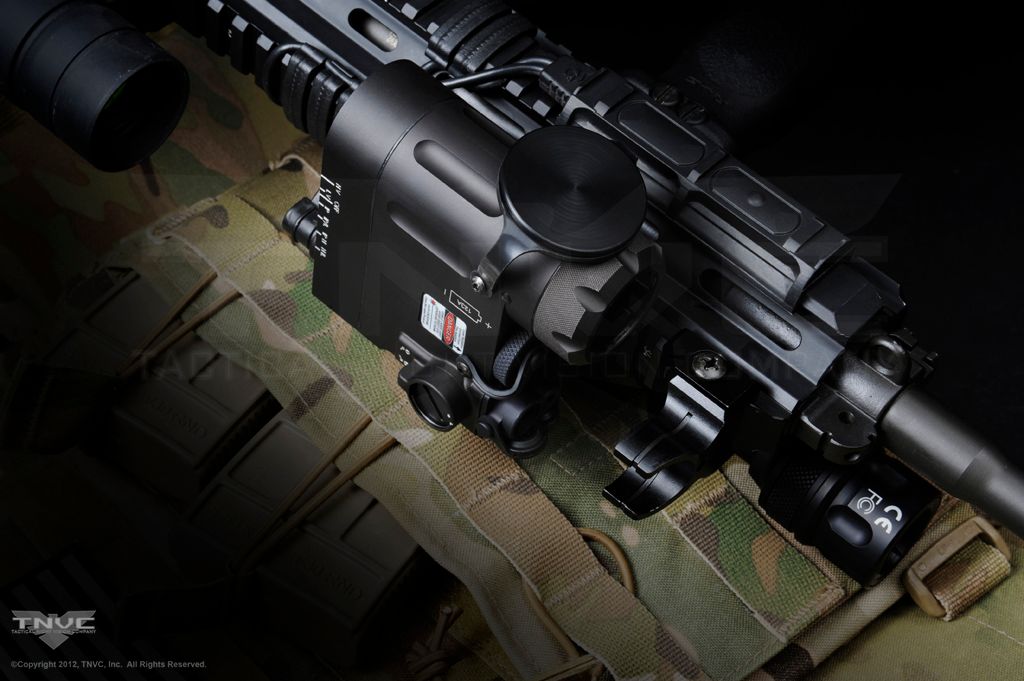 LDI DBAL-D2: Initial Review, 01-21-12
SPECS:
LDI DBAL-D2: Initial Review, 01-21-12
SPECS:
Dimensions: 3.85”(L) x 3.37”(W) x 1.59”(H)
Weight: 12.5 oz.
Housing: 6061 Aircraft-Grade Aluminum, T6 Mil-Spec Hard Anodized
Power: One (1) CR123A 3-Volt Battery
Battery Life: 1 Hour on HIGH Power
Waterproof: Submerged 20 Meters
Warranty: 1 year
IR LASER:
Class: Class1 Eye-Safe
Output: 0.7mW
Divergence: 0.3 mrad
Wavelength: 850nm
Range: Up to 250 yards
VISIBLE LASER:
Class: IIIa
Output (High/Low): <5mW/ <1mW (Red or Green)
Divergence: 0.3 mrad (Red), 0.5 mrad (Green)
Wavelength: 635nm (Red), 532nm (Green)
Range (Day/Night): 10m/ 500m (Red), 30m/ 1,500m (Green)
IR ILLUMINATOR:
Class: Class1 Eye-Safe
Output (High/Low): <600mW/ <300mW
Divergence: 2° to 30°
Wavelength: 850nm
Range: Up to 800 yards
INCLUDES:
DBAL-D2 Multi-Function Laser
LDI Quick-Detach H2 Throw Lever Mount
One (1) CR123A Battery
7” Remote Cable Pressure Pad Switch
Operator’s Manual
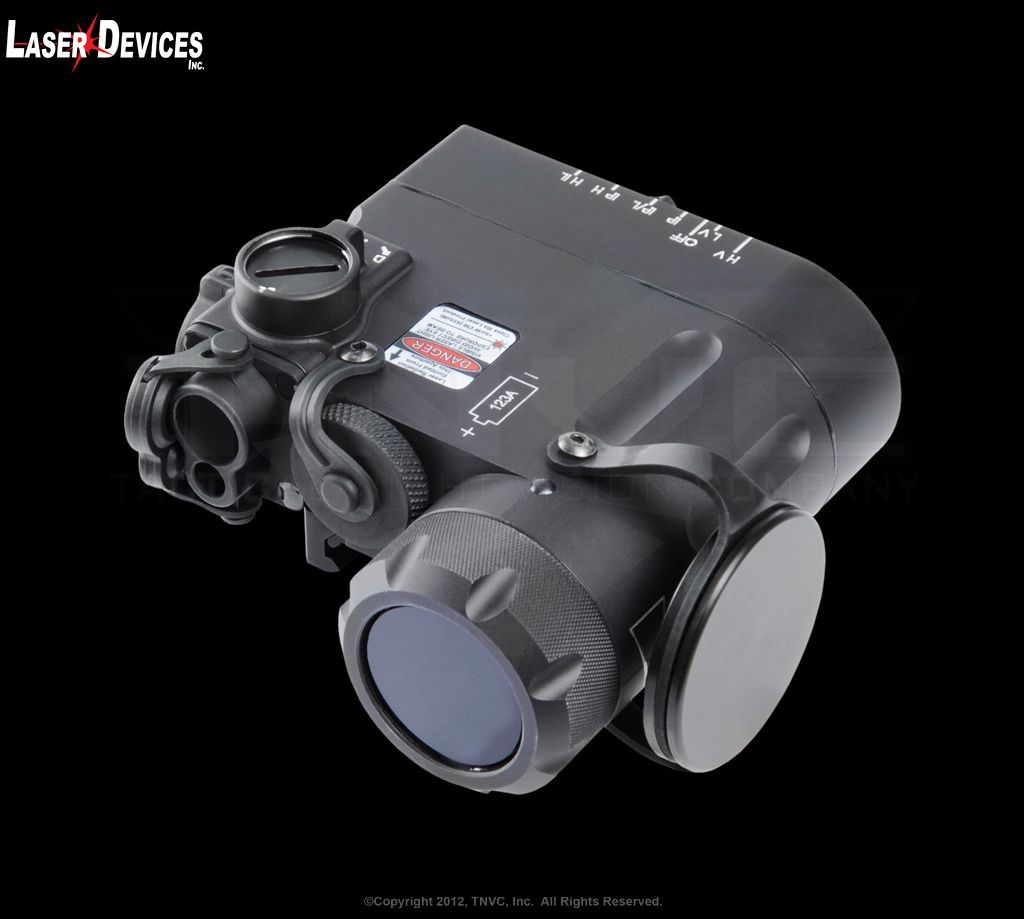
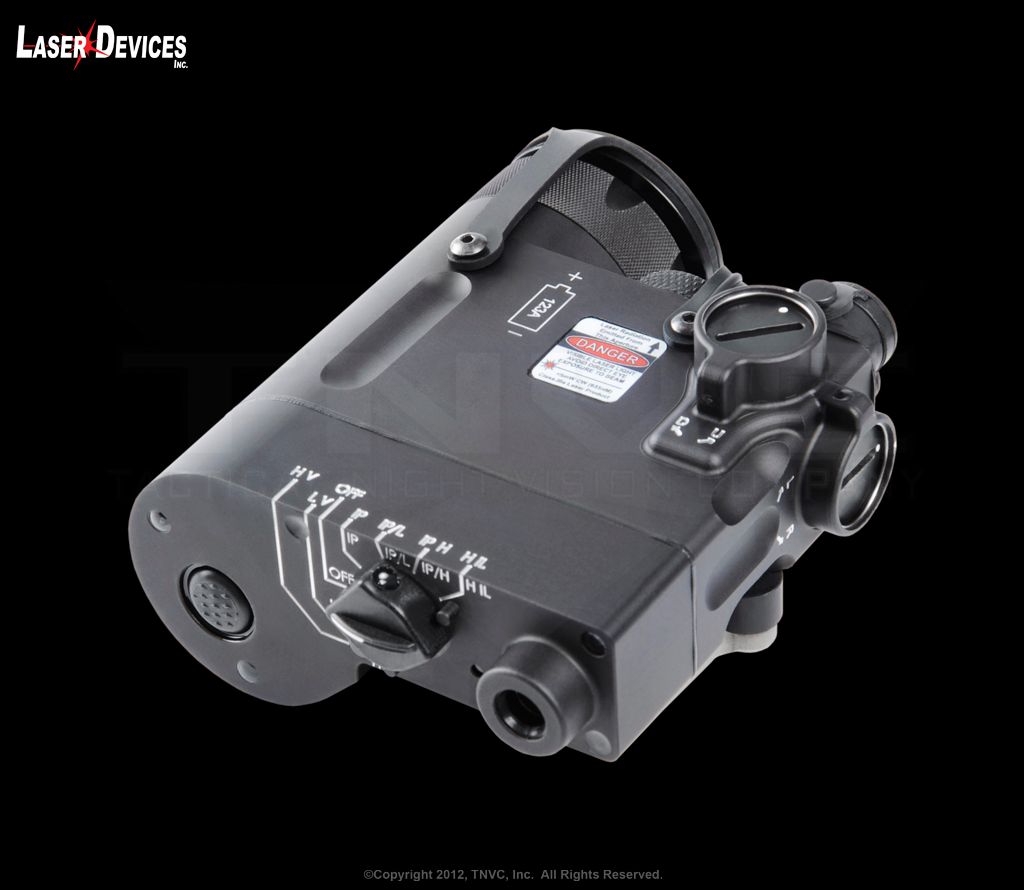
Now that the 2012 SHOT Show has come and gone, Laser Devices, Inc. has granted its distributors permission to begin talking about their new DBAL-D2 Class1 Infrared Laser. Up until the end of SHOT, LDI Distributors were under strict NDA to not discuss the specs or performance of the unit due to the finalization of patent filing. TNVC was contacted to evaluate the DBAL-D2 several months ago. When the project manager first disclosed the development of the DBAL-D2, we were extremely intrigued. We were honored to be asked to test the prototype. As you read this review, it is important to remember that the feedback is based on a prototype unit and that the final production model will feature several changes. These changes will be minor, but based on our feedback provided to the manufacturer at SHOT Show, they will improve the usability of the unit. The extreme success of the original Class1 Infrared Lasers, launched last January by LDI, has certainly been one for the books. And while they brought night vision shooting in the civilian market to a whole new level, there was still a request/need for the inclusion of an integrated IR Illuminator (such as that seen on the AN/PEQ-15 ATPIAL and AN/PEQ-15A DBAL-A2). However, these units’ Illuminators are lasers and the power required to make them powerful enough to be useful would far surpass the spec for Class1, which mandates power below 1mW. So, in developing the DBAL-D2, Laser Devices, Inc. decided to include an LED IR Illuminator, which is inherently eye-safe.
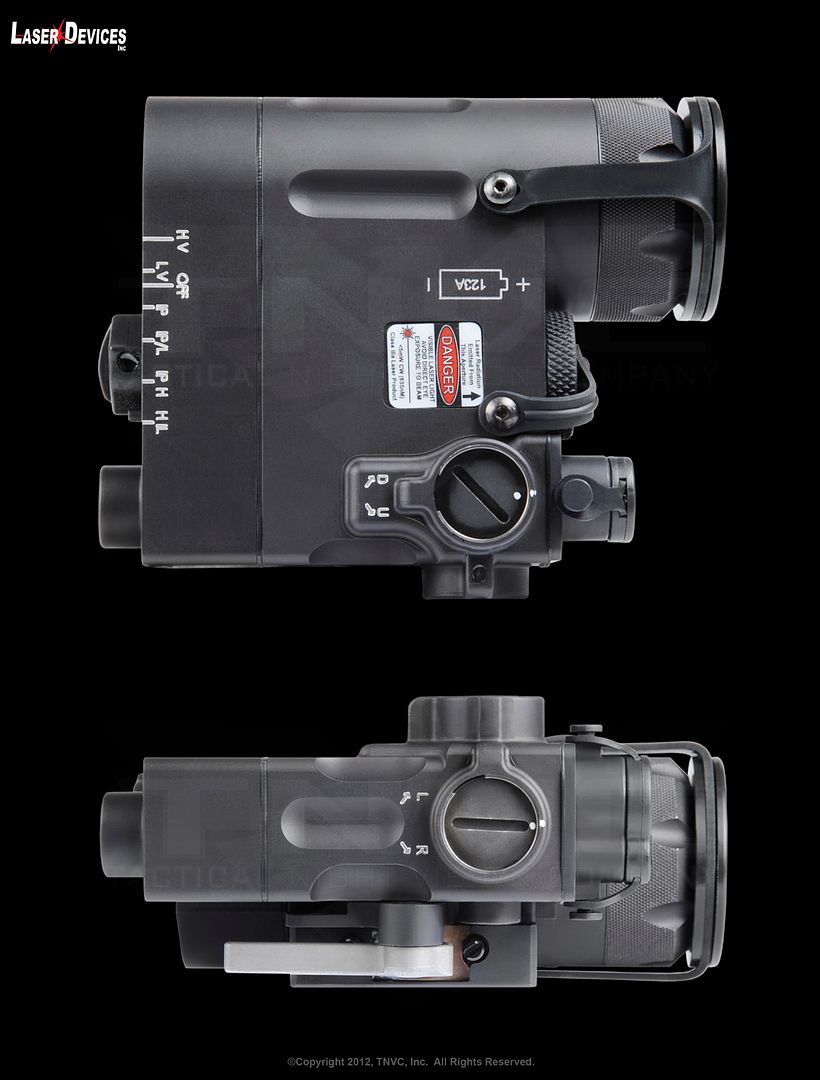
LDI’s Class1 IR Lasers are 0.7mW and have a reach of about 250 yards. But, in order to stay within the FDA regulation, LDI needed to integrate an LED IR Illuminator. This brings us to the first thing you will notice about the unit: it’s big. The very prominent IR Illuminator certainly takes up a large portion of the physical appearance when compared to the legacy DBAL-I2 and government-only A2 models. This is because it needs to house an IR LED array large enough to produce a useful output. LDI’s goal was to create an Illuminator that was powerful enough to reach out to long distances. I will get to our findings on its performance shortly, but let’s take a look at the physical characteristics first. The DBAL-D2 housing is based on the government-only DBAL-A2 body. About 60% of the housing of the D2 is identical to the A2. The right side of the unit features a piggy-backed and slaved visible and Class1 IR Laser. Familiar windage and elevation adjustments are found on the top and side of the unit with the battery compartment facing forward in the center front of the housing. A central indicator knob is located in the center rear of the D2, facing the shooter for easy access. The left side of the unit houses the large LED IR Illuminator. This is where the changes begin. The body housing bulges to accommodate the 1” diameter illuminator bezel. The illuminator housing stretches 3” in length and is tipped with a rotary focus ring that is knurled for easy actuation in the field. I found the illuminator head to be easily turned because it is thick enough to allow a lot of purchase by the fingers. The bulbous illuminator housing is needed to accommodate a large-enough LED that would produce the desired throw/spill.
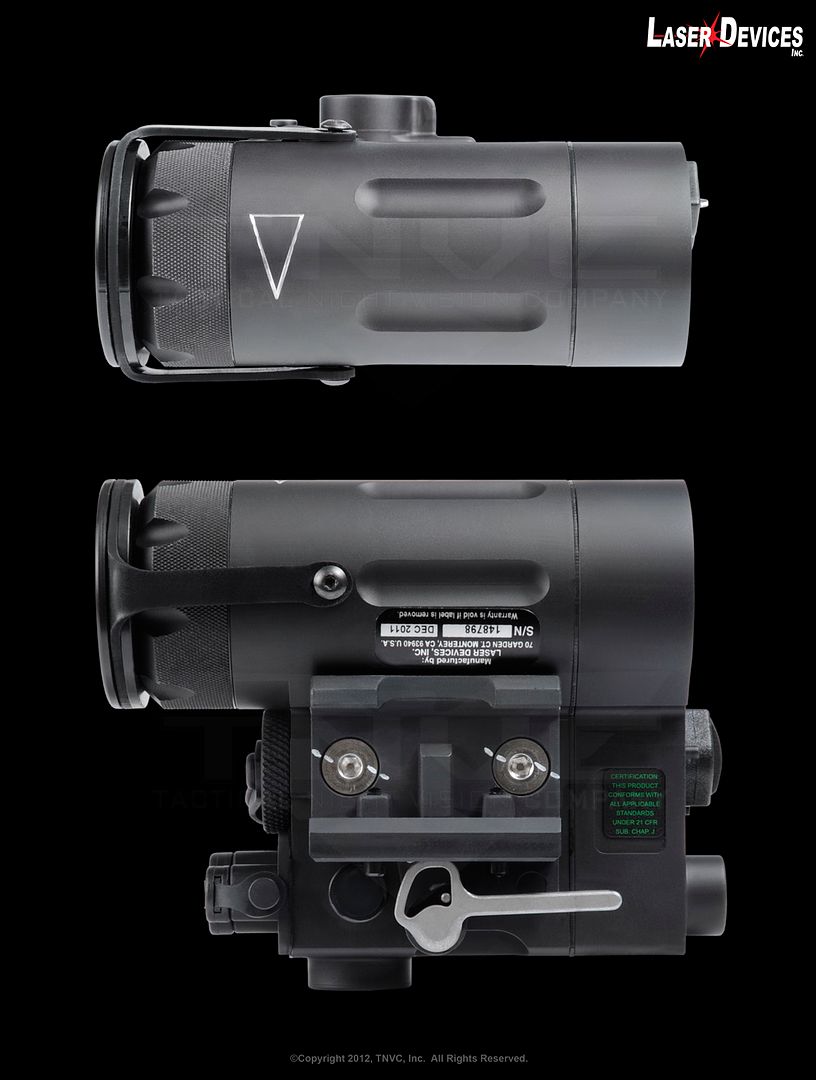
The top of the housing is flat and spills over the left side into the illuminator housing, making it sit partially below the 1913 rail of the host weapon platform. This design challenge caused the engineers to choose between the lesser of two evils. Had they decided to let the main body housing intersect the illuminator in the center, the resulting bump on the top surface would have severely interfered with the shooter’s sight picture. As it is, the DBAL-D2 (like all DBAL units) is tall and invades the lower portion of the sight picture through an Aimpoint or Eotech sight, when mounted on the top rail, more than an ATPIAL. The D2 is actually taller than the legacy I2 and A2 devices. It sits approximately 1.25” (1.1875” to be exact) off the surface of the rail. This is mainly caused by the inclusion of the excellent LDI H2 throw lever mount, but the housing itself is actually thicker as well. Legacy DBAL-I2 and A2 systems sit about 1.0625” off the top of the rail, making the DBAL-D2 1/8” taller. In my trials, I found that the sight picture with a standard co-witness was too obscured by the DBAL-D2 at the 12 o’clock. But, mounting your sight with a tall mount that places it at the lower 1/3rd co-witness height gets rid of this issue. There are plenty of tall mounts available for all the popular sights. So, while the combination of a taller housing and H2 mount increases the height, the overall durability and functionality of the DBAL family attachment system is greater. So, I think it’s a fair trade-off. The solution is to simply mount the optic in a taller mount that places it at a lower 1/3rd co-witness with the iron sights. This increases the optic height for a better cheek weld while un-cluttering the sight picture at the same time. While we’re on the topic, let’s quickly discuss laser placement.
Laser Aiming Systems are just that: aiming systems. They are used in situations where it is not ideal to engage a target or threat with an optical or iron sight such as when using night vision goggles or while wearing a gas mask. It is my professional opinion that mounting a laser system at the 12 o’clock position will produce the best results for the shooter. The reason is simple. After proper zeroing of the device, the laser point of impact will coincide with the bullet point of impact at the desired range. However, the laser will continue on to infinity (or until it runs out of power) while the bullet will be affected by gravity and drop towards the earth. Like a shooter knowing his/her holds for the red dot at various distances before and after the POA/POI, the laser is used in the same way. So, the shooter only has to compensate for elevation with a properly zeroed laser and weapon optic. However, when a laser is mounted at the 3 or the 9 o’clock position, a whole new variable comes into play: windage. Now, the shooter’s round is going to cross the laser at the desired range (point of impact). And, the shooter’s “hold” at ranges up to the POI are relatively straight forward. But, after he POI, the laser will continue left or right of the bore, relative to the laser position. So, the shooter now has to compensate for windage and elevation holds at distances past his/her zero. This makes target acquisition slower and more complicated, increasing the chances you will miss your target. So, unless an optic, clip-on sight, grenade launcher sight, or other piece of mission-essential kit precludes you from mounting the laser at the 12 o’clock, you should place it on the top rail. But, I digress…
Height comparison: DBAL-D2 and ATPIAL in front of Aimpoint CompM4s (M68 CCO) in standard height mount
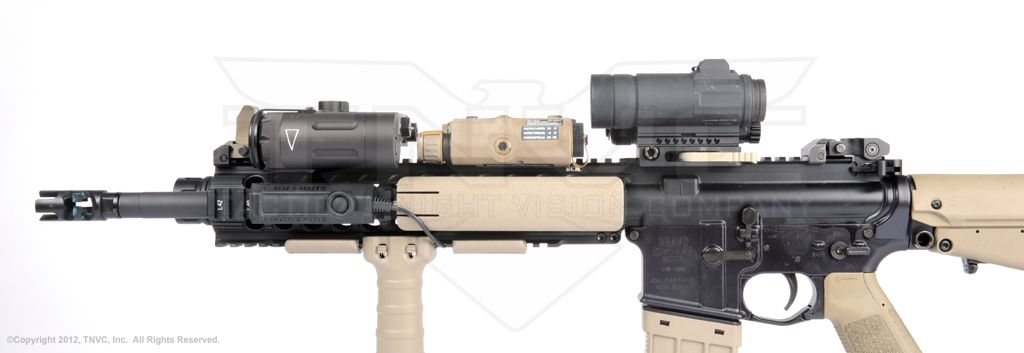
Height comparison: DBAL-D2 and DBAL-I2 in front of Aimpoint CompM4s (M68 CCO) in standard height mount
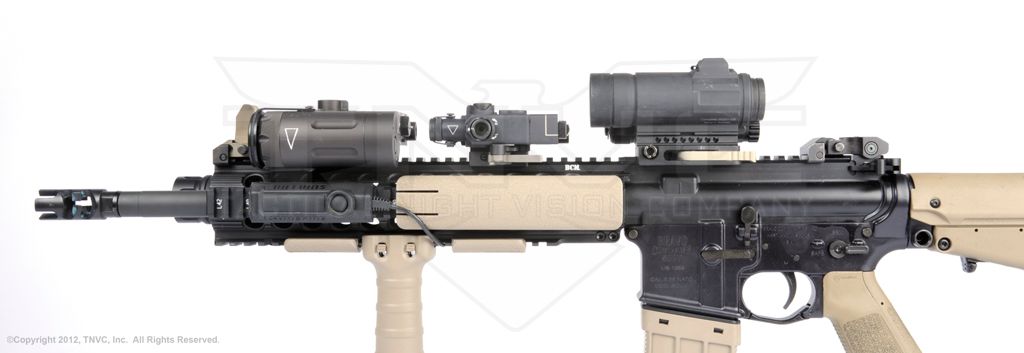
Anyway, the DBAL-D2’s large infrared illuminator cascades over the side of the rail and hugs the recessed space between rails. The bottom of it is approximately 0.50” from the adjacent rail, possibly causing a real estate issue with certain weapon light mounts. While this is a minor issue, it is something the user should be aware of when setting up his/her weapon. But, like I said; it is certainly the lesser of the two evils when compared to obscuring your sight picture. And with the plethora of weapon light mounts on the market, you will surely be able to find your way around this interference.
The DBAL-D2 is big, but it’s a solid unit. The thing is built like a proverbial tank, weighing in at 12.5 ounces with a battery installed. Unlike a lot of the lasers and illuminators out there, you could beat someone to death with the DBAL-D2 and it will still work. The D2 is about the size and weight of an AN/PEQ-16B, so it’s not incredibly unwieldy. But, you will definitely notice it on a rifle.
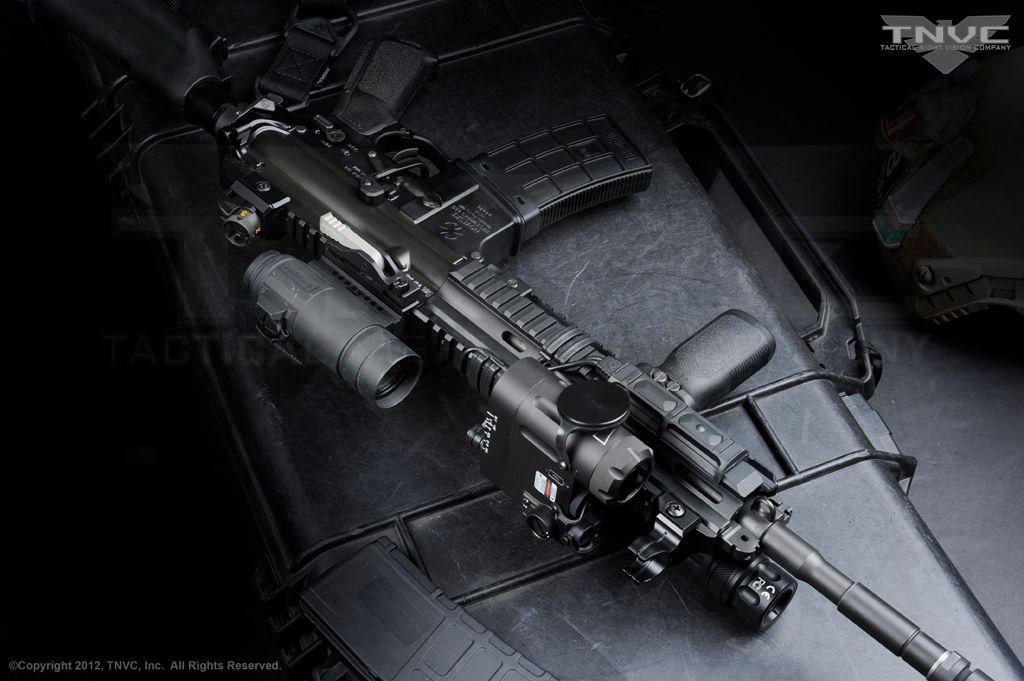
The next thing you will notice is the placement of the fire button. Traditionally, the fire button is located on the top of the laser device so the user can reach over with his/her thumb to activate it. But, because of the space taken up by the illuminator, access to a top-mounted fire button would be limited only to those with giant bear paws for hands. So, the DBAL-D2 features a rear-mounted fire button. Located at the rear of the illuminator portion of the housing, it can be easily activated by the user’s thumb while shooting with a thumb break method. It requires a deliberate motion which is good because it lessens the chance of an accidental discharge of the laser. Something to keep in mind if you are using the fire button for actuation of the unit: it needs to be placed relative to your grip if you don’t want to break your grip to activate the laser. But, if you plan on using the included remote pressure pad, then this is a non-issue. The prototype’s fire button sits flush to the surface, making it hard to find while wearing gloves. Per my discussion with LDI’s staff at SHOT Show, a raised frame around the fire button will be added for increased tactile feedback, making it easier to find the button. Also, it should be noted that the placement of the fire button on the left rear of the housing will make it virtually impossible for a left-handed shooter to reach. This means that south-paws will have to use the remote pressure switch. By the way, actuation works the same as other DBAL’s. Pressing and holding the fire button or remote switch provides momentary activation while double tapping provides constant-on for 5 minutes.
Fire Button is actuated with left thumb
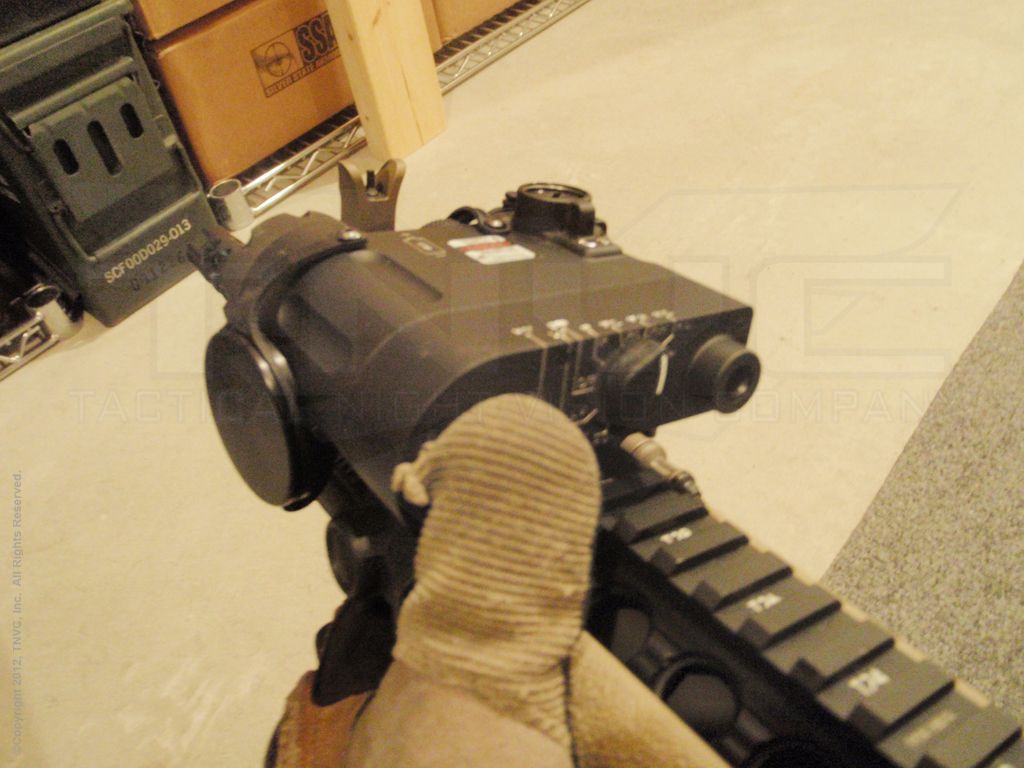
Size of Illuminator would cause issues for smaller hands if Fire Button was placed in traditional location
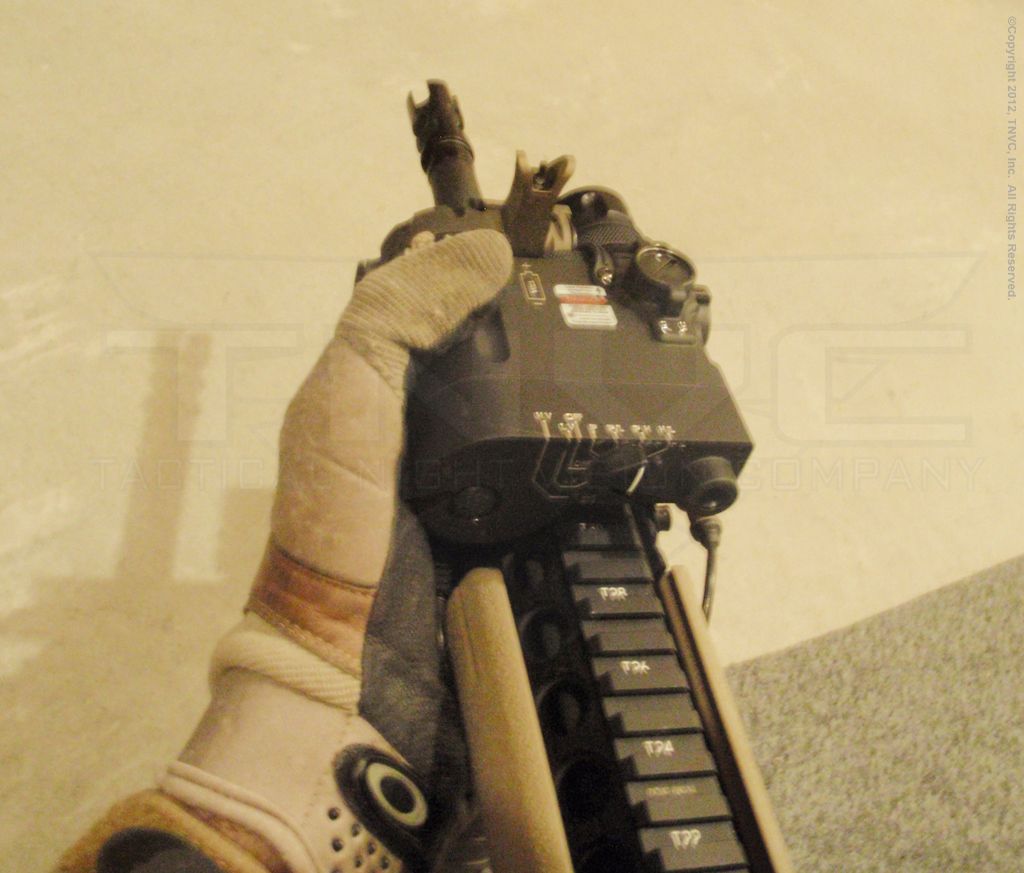
On to performance:
The DBAL-D2 is a triple-function laser module. It features a visible laser (available in either red or green) and a Class1 infrared laser (making it eye-safe and available to civilians). The lasers are slaved, so zeroing one, will zero the other. The laser power is the same as the legacy Class1 units. The visible laser is the same power as a standard AN/PEQ-15’s visible laser (Class IIIa), with a high power of 5mW and a low power of 1mW. The infrared laser is Class1 (0.7mW) and has no high/low change. The AN/PEQ-15 features a 5mW IR laser low setting and 25mW high setting. So, like the other Class1 lasers, the DBAL-D2 does not have the same power of a standard IIIb unit. But, the DBAL-D2’s Class1 IR Laser will reach out to 250 yards which is more than enough for practical purposes. While a standard Gen3 night vision goggle has a detection range of several hundred yards under optimal lighting conditions, its identification range is only 100-115 yards. This means that while you can see a man or animal moving around at longer ranges, you won’t be able to properly identify them as friend/foe or coyote/neighbor’s dog until they are within about 100 yards. So, a 250 yard laser range is more than enough for civilian-level engagements. Longer range military lasers are only used for communication with aerial assets and other teams. So, if you have air on station while hog-hunting, good on you; go find a standard power laser. If not, then the 0.7mW Class1 is just fine.
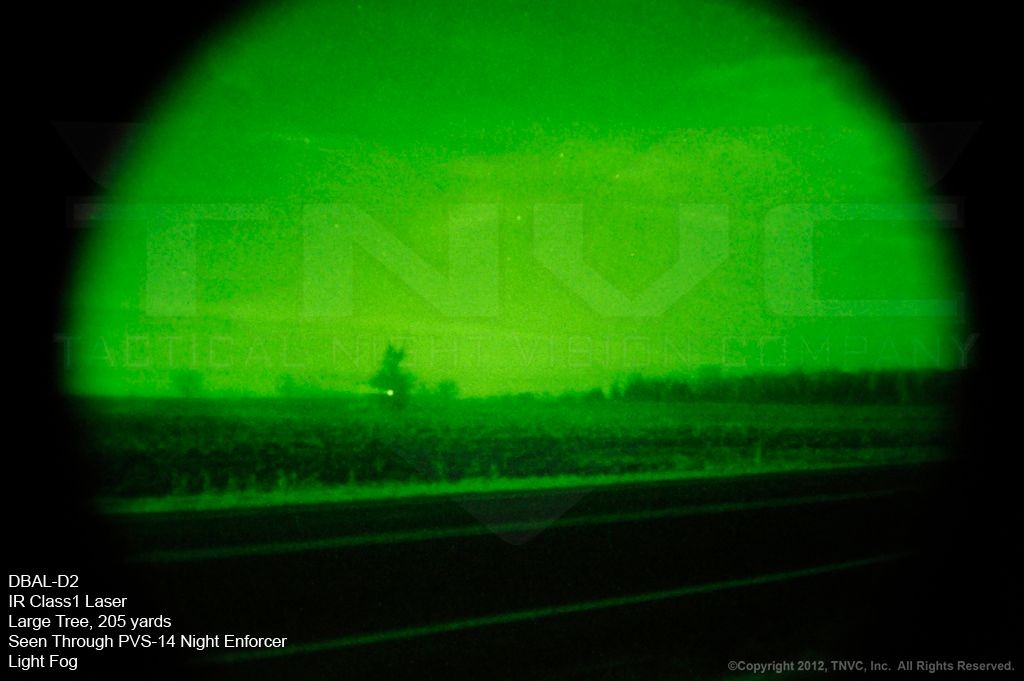

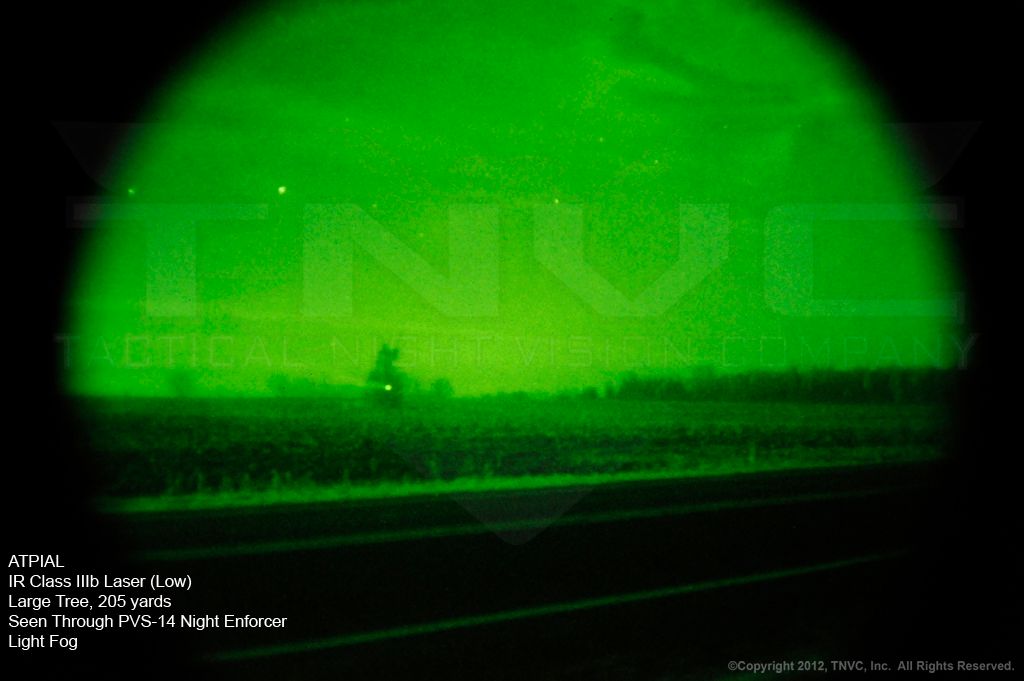

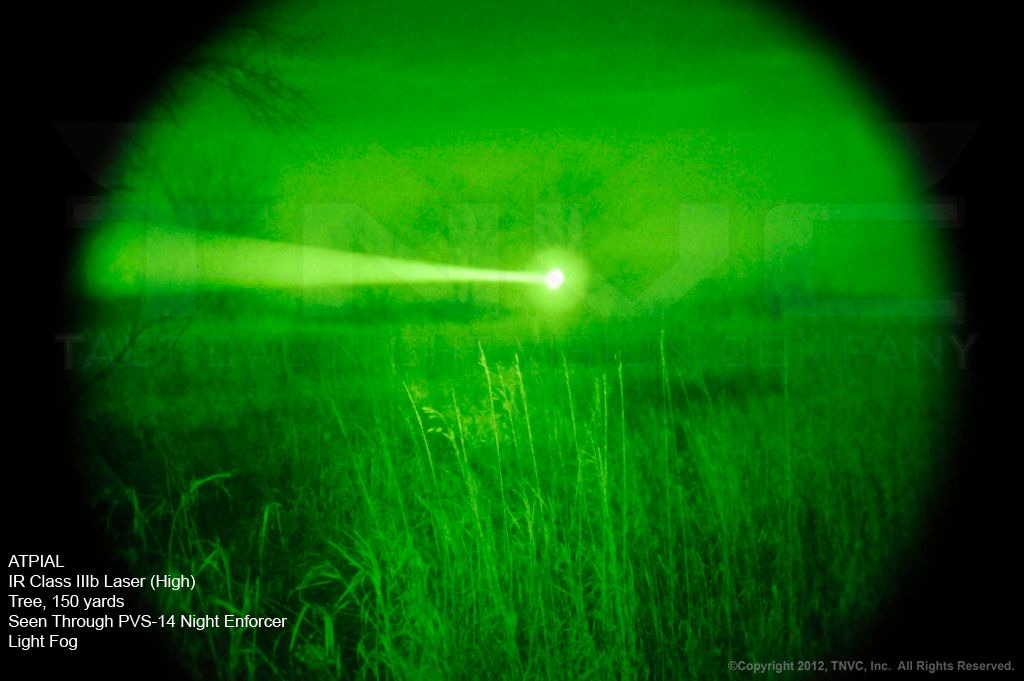
Now, on to the LED Illuminator: The Illuminator is the meat of the DBAL-D2. It completes the package and makes the unit a true do-all device for the commercial market and the closest a civilian will get to owning a AN/PEQ-15(A). The illuminator is focusable from 2° to 30° by turning the knurled bezel. This allows the user to cast a wide beam with a shorter throw or a narrow beam with a long throw. The short range/wide beam was useful for illuminating a field out to about 60 yards. I could see into the tall grass to check for movement. Up close, there was a decent amount splash, but this was dissipated by moving the edge of the illumination cone off the foreground. One thing of note here is that even when the illuminator was opened all the way up, a crisp beam edge could be seen. This defined circular cone had very little diffusion. In this way, the DBAL-D2’s illuminator mimics the AN/PEQ-15(A). However, at the widest setting the DBAL-D2 actually seemed to edge out its government-only brothers. This is due to the difference in output between a laser generated and LED generated light. I did have to take care when passing the illuminator across close-in objects. Even when opened up, the un-focused beam will bloom off of trees and other large surfaces. The illumination is so great at this point that the surfaces reflect the light and all detail is lost. But, this is something that both the DBAL-D2 and AN/PEQ-15(A)’s have in common. However, through my direct observation, the DBAL-D2 was actually brighter at its widest setting.
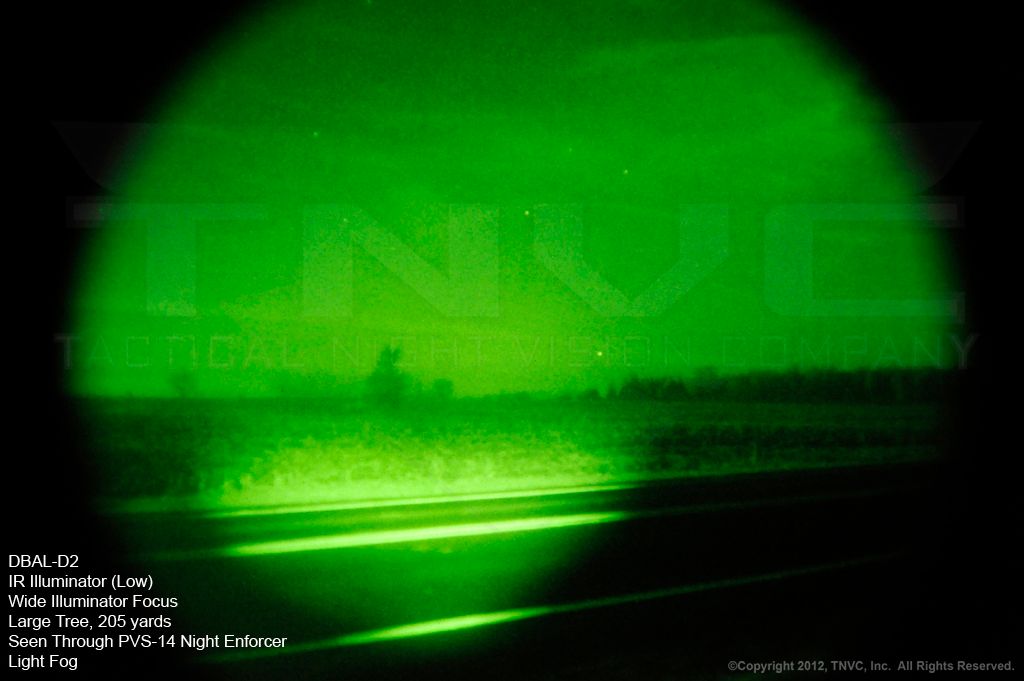
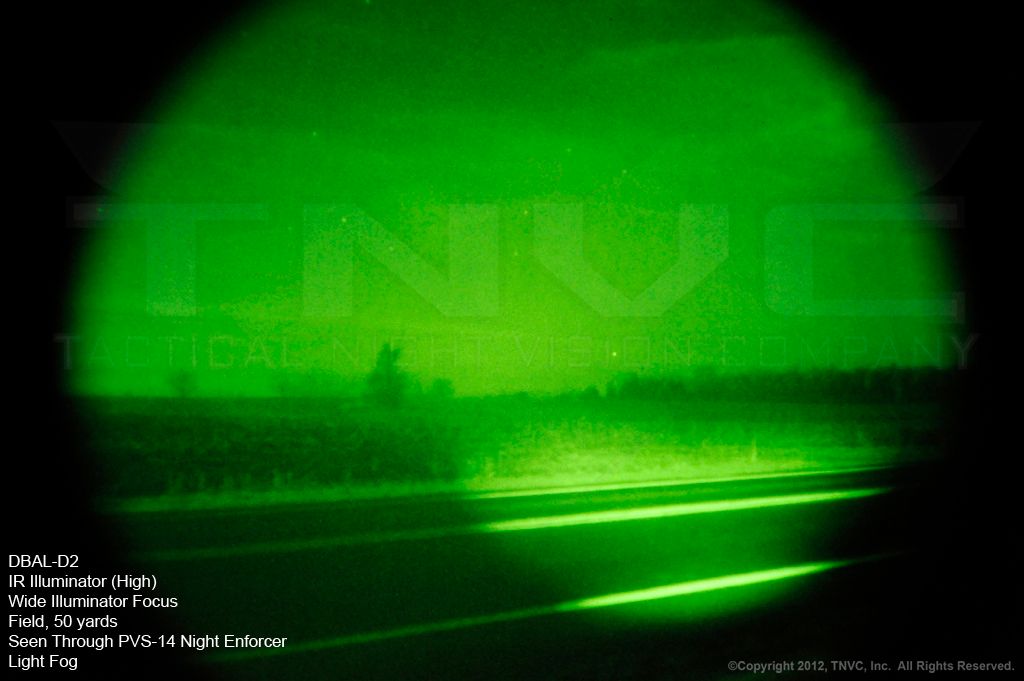
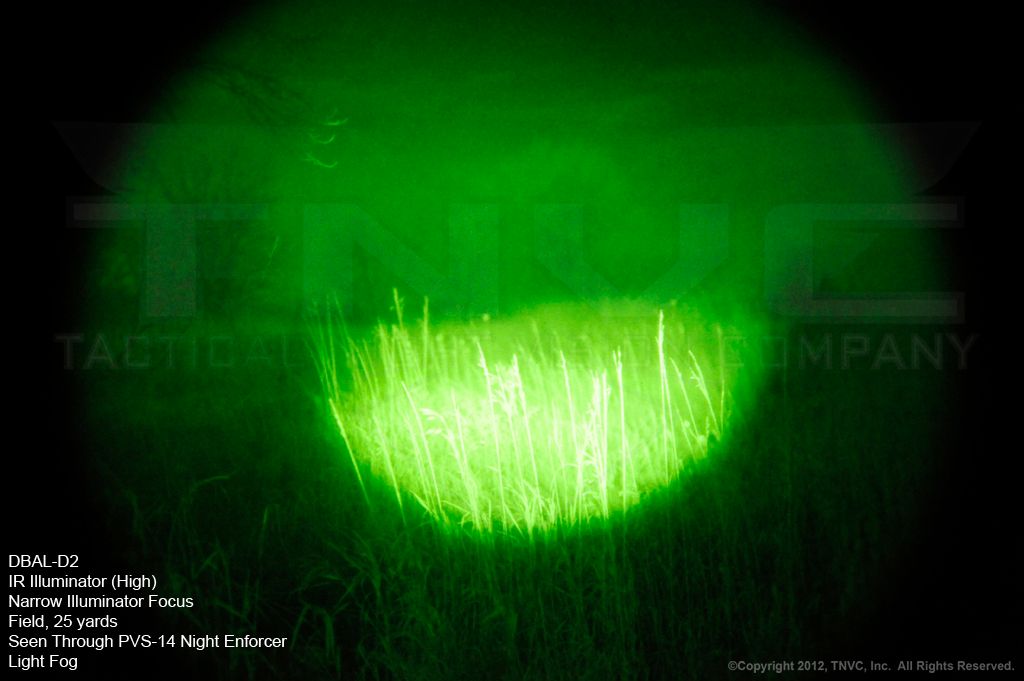


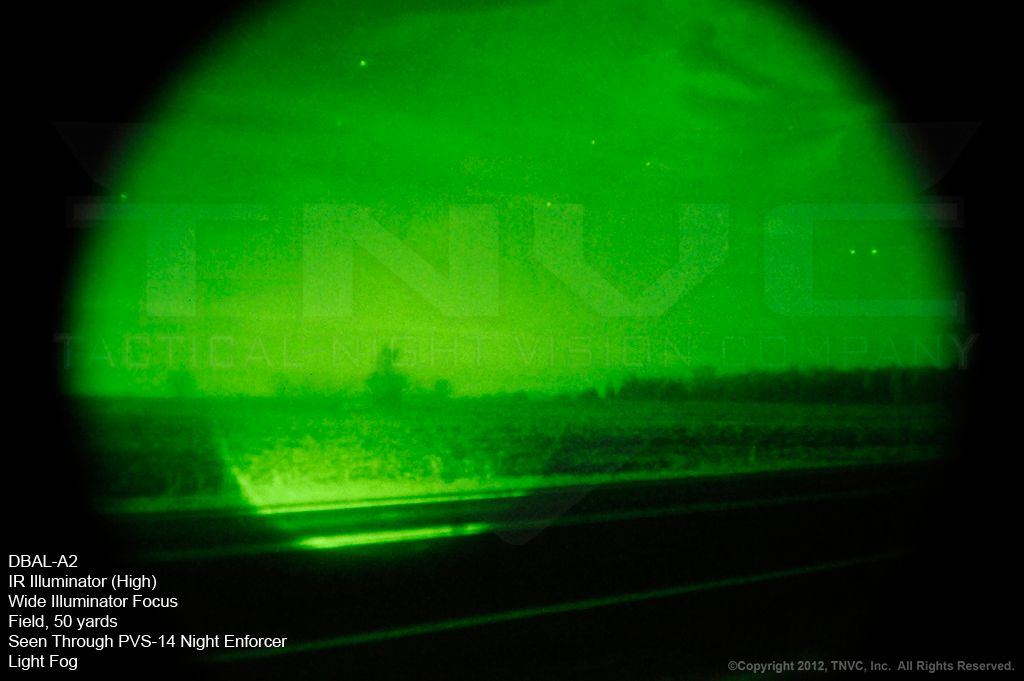
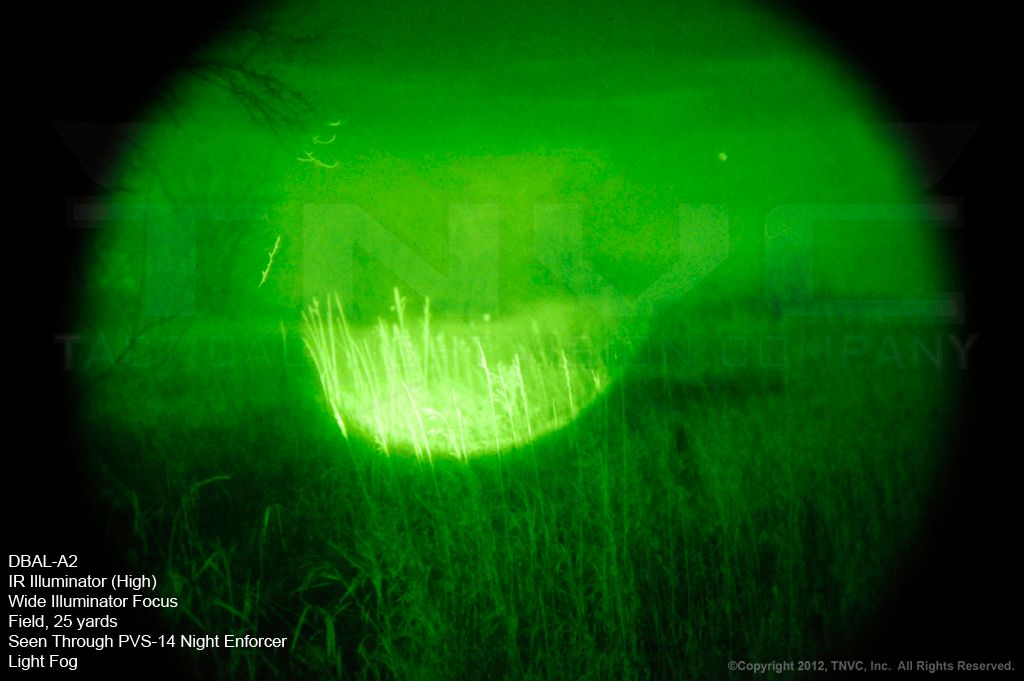
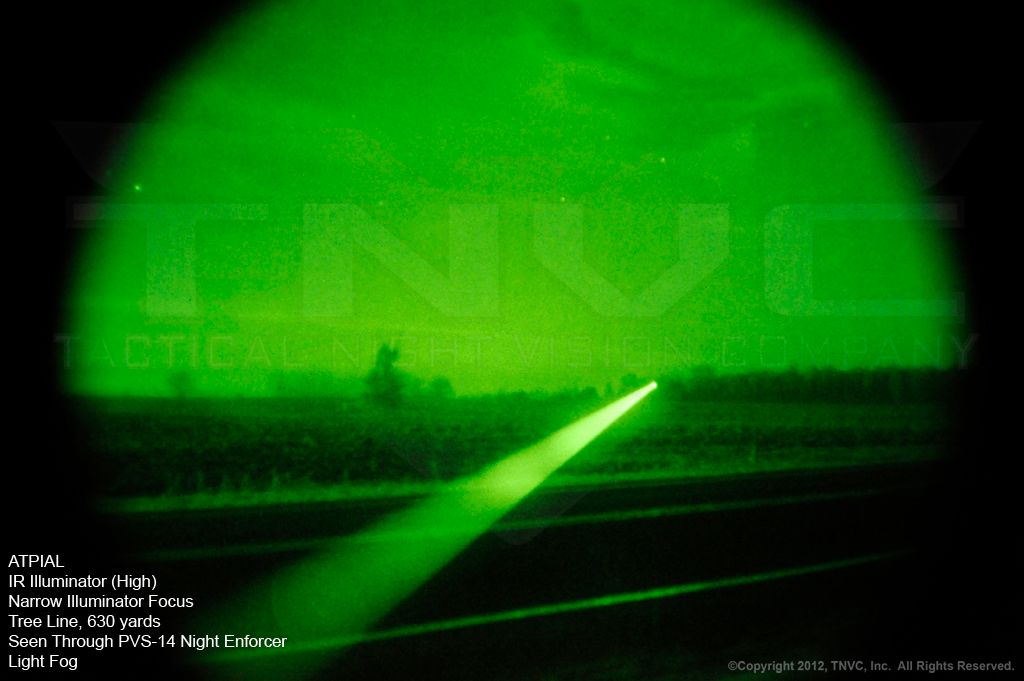
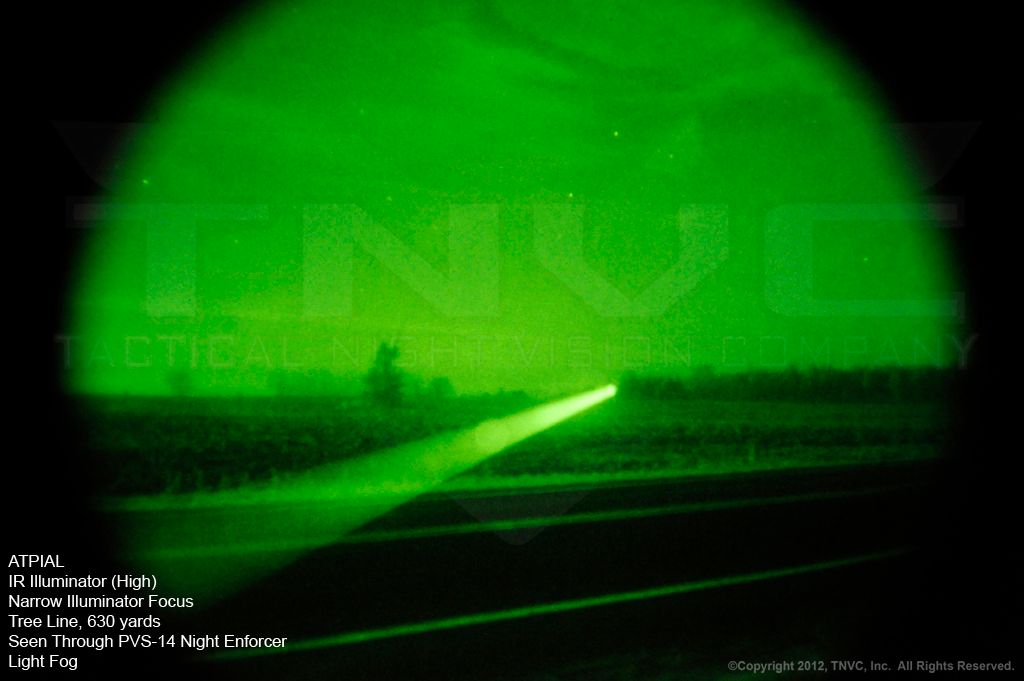
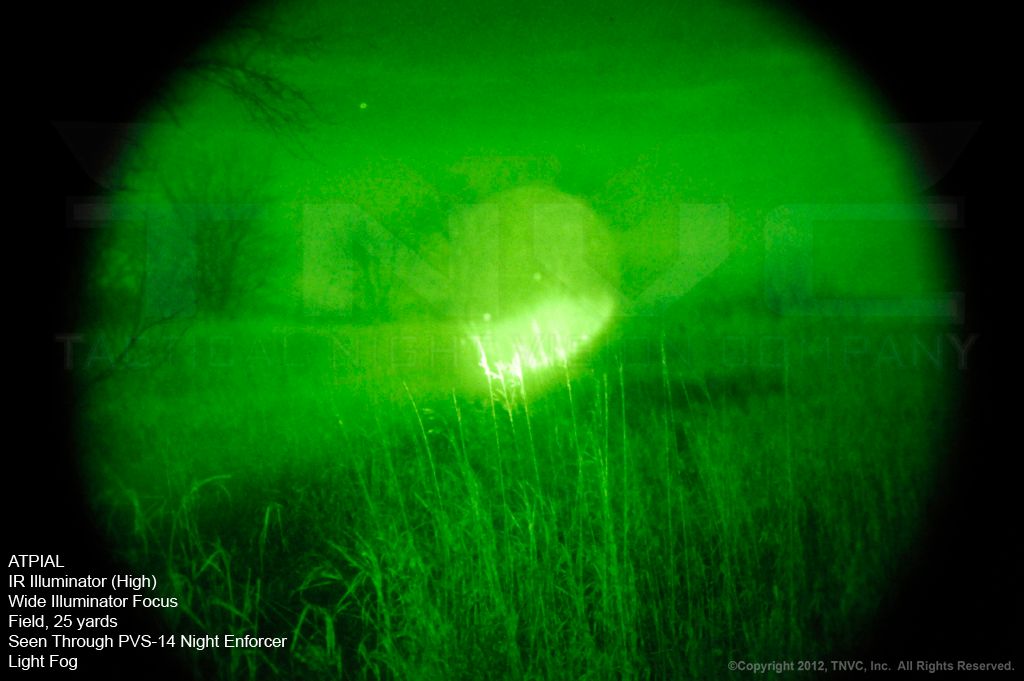
Now here’s a shocker: the Class1 IR Laser beam was not washed out by the illuminator. Yup, read that again and let it sink in. I could easily target objects from 50 yards on out, without the laser washing out. The only time I experienced any wash out was when the illuminator and laser were shining on a close-range wall. The bloom effect of the illuminator was too much even at the low power. But, for outdoor hunting and sport shooting, the two outputs work together flawlessly as evidenced by the photos.
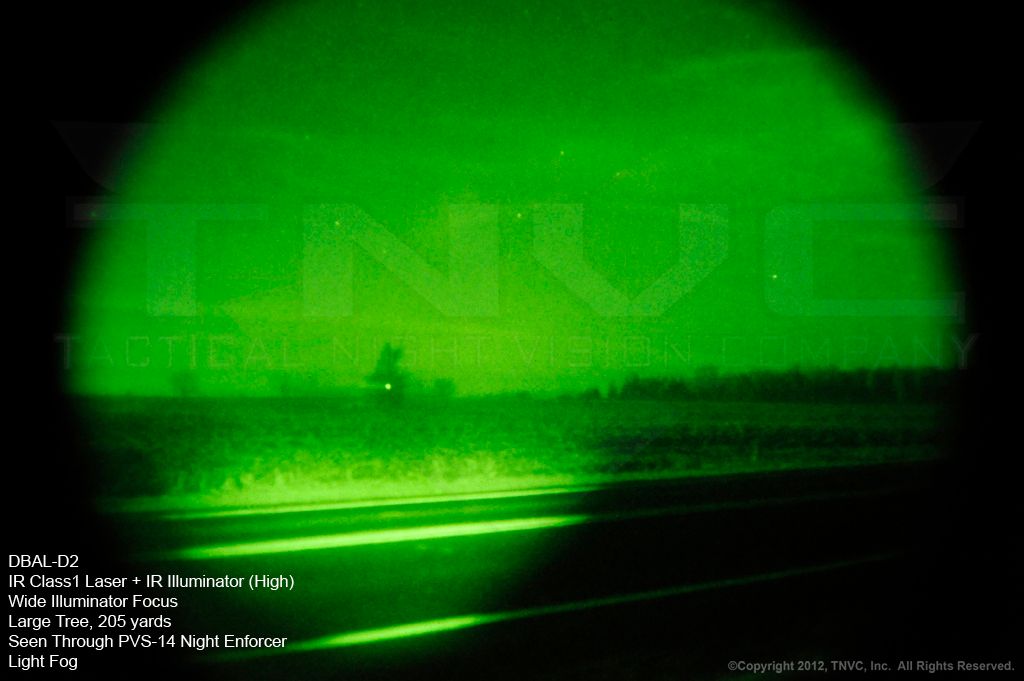
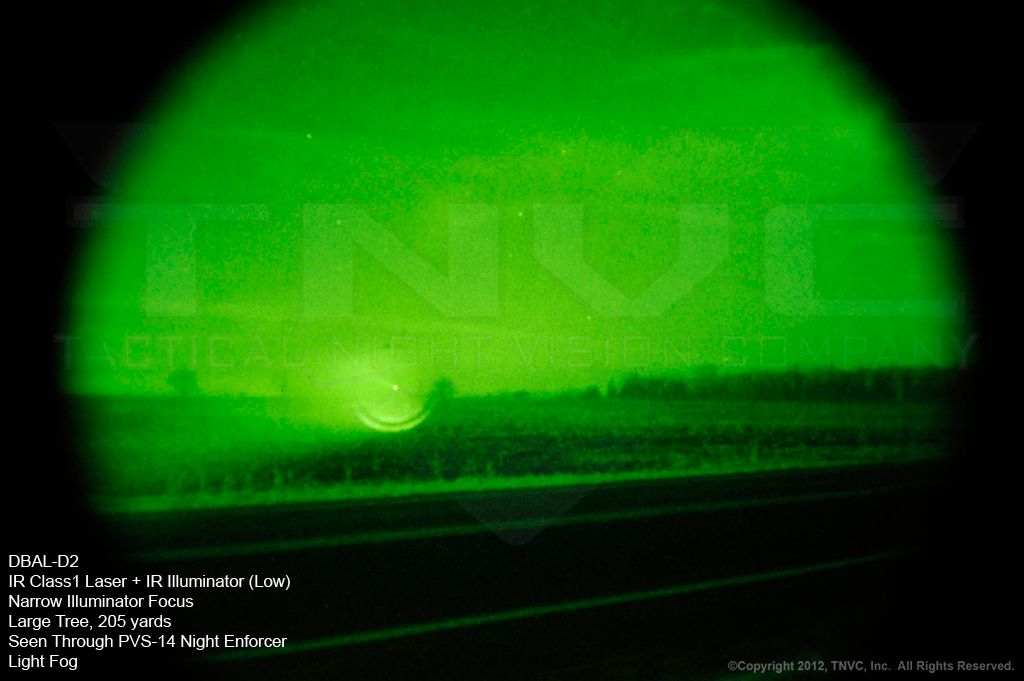
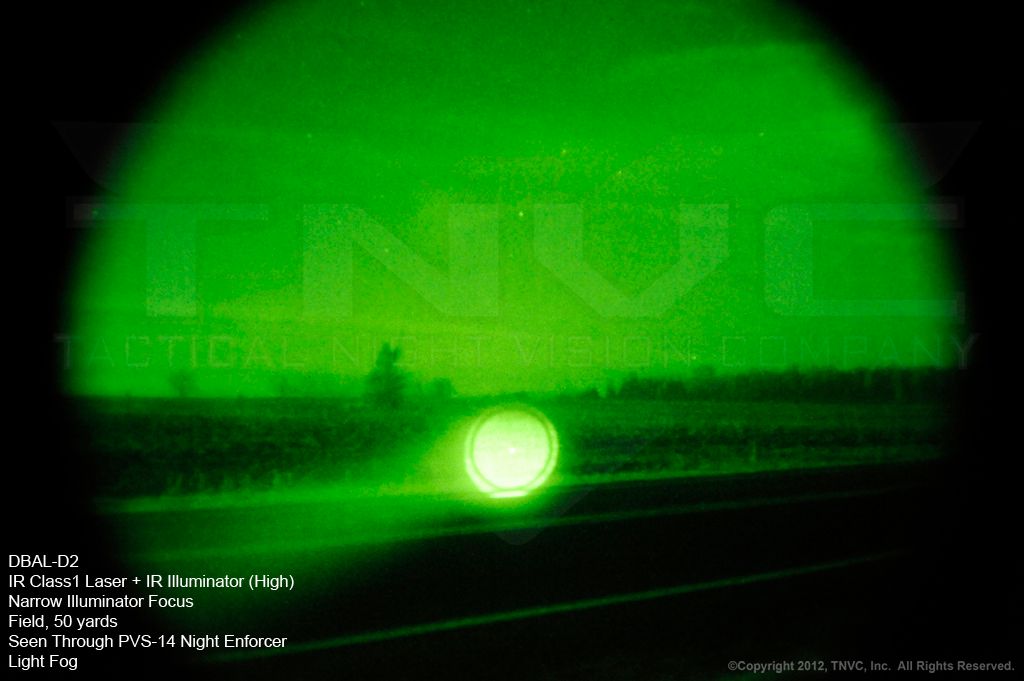

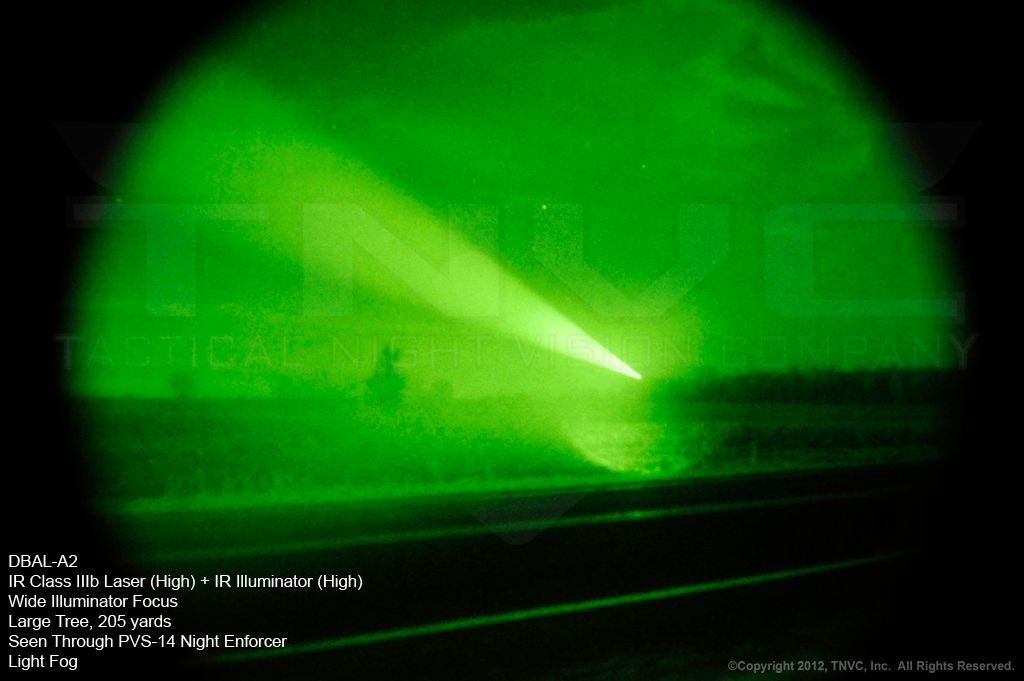
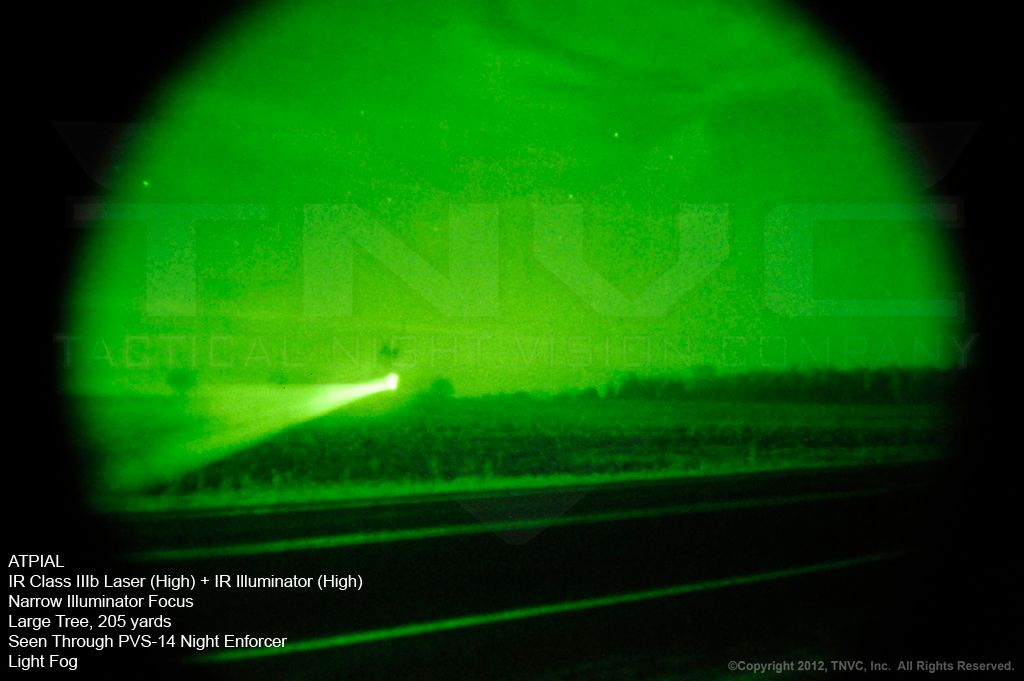
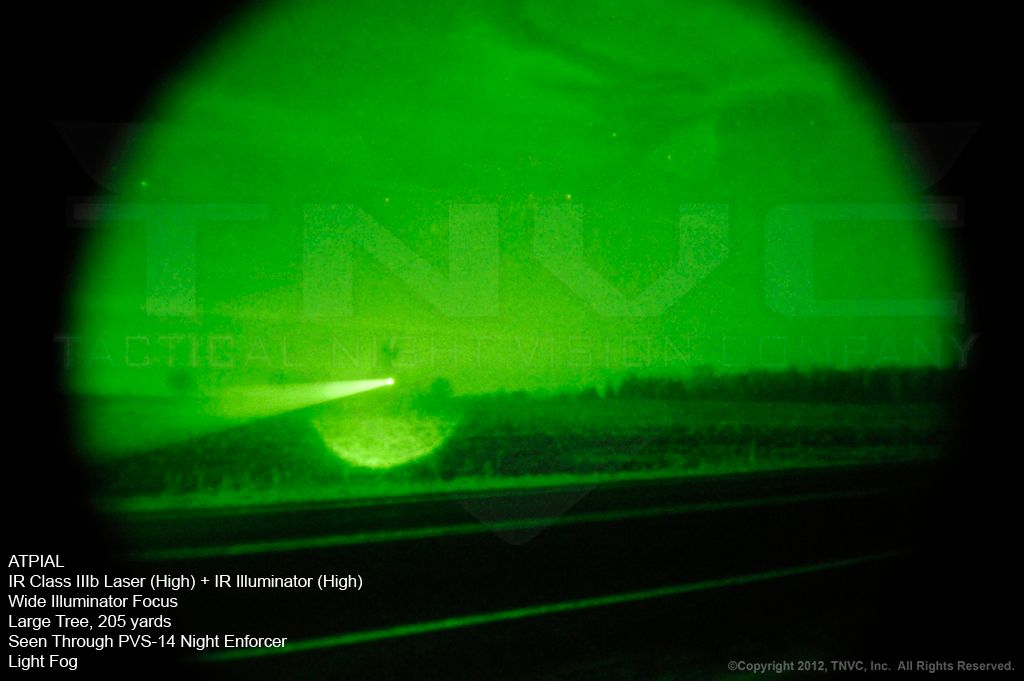
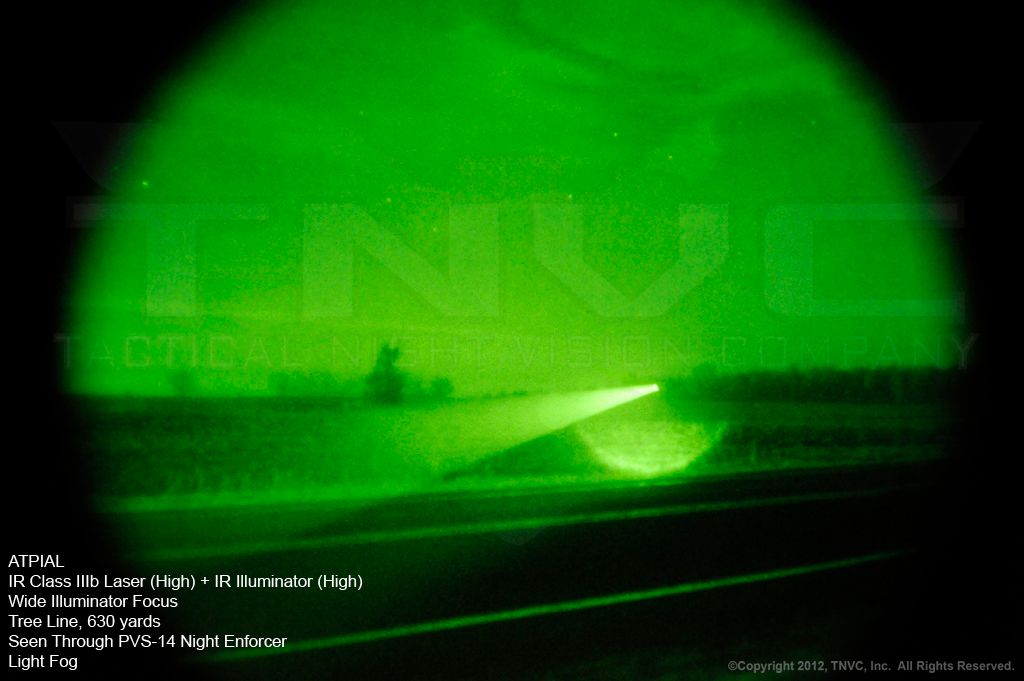
When focused all the way down to its narrowest beam pattern, the DBAL-D2 displayed an impressive reach. Using a laser range finder, I measured the furthest distance of visible IR illumination at about 800 yards (using a Leupold spotting scope and L3 CNVD-LR). The use of the CNVD-LR was to truly check for distance. Without magnified optics, it is impossible to accurately determine the true range of an illuminator. The determining characteristic for this measurement included me having to pan the unit across a distant tree line and look for a change in visibility. This was a slight difference, but it benchmarks the capability of the unit. However, considering the size of the DBAL-D2’s illuminator, this distance does not seem all that unobtainable. But, keep in mind that this was a display of the longest throw that I could discern a difference in the amount of light on a surface (in this case, a distant tree line). It does not necessarily represent useable illumination. As for the furthest useable distance, I was able to detect the movement of a deer in the same field at about 740-750 yards. Obviously, movement is impossible to relate through still photos, so you are just going to have to take my word for it. But, you can see the distance I am describing in the photos. When dialed down to the narrowest beam/longest throw, the DBAL-D2 looks surprisingly similar to the AN/PEQ-15(A) in performance. In fact, the DBAL-D2, like the DBAL-A2, has a more defined beam edge. I feel this is noteworthy since the crisp edge not only helps the user identify the area he/she is observing, but anything of merit, such as movement towards the edge of the beam can be more easily seen. In this comparison, both DBAL units beat the ATPIAL (AN/PEQ-15) in overall brightness. But, it should be noted that this is not always ideal. While a tightly focused beam can provide benefits, such as those mentioned above, it can also hinder the user’s ability to identify things within the cone of illumination. Sometimes, the illumination is so intense that it will reflect off surfaces too much, effectively washing out the area of observation. Obviously, this is not ideal. But, it heavily depends on the area being observed. Man-made objects tend to the have the most reflective surfaces. It may be hard to decipher in the photos due to the limitations of photographing through night vision. Another thing to take into account is the illuminator’s ability to refract off of atmospheric particles that present in fog or high humidity. With the DBAL-D2’s high power LED illuminator, these particles can appear to sparkle in or diffuse the visible area. In this case, I would recommend changing between the high and low settings of the illuminator to help better identify the target area. Overall, the DBAL-D2’s LED IR illuminator did appear to outperform the ATPIAL on a purely academic level.
Something to take into consideration is the visible signature of the device. While the main market for the DBAL-D2 is the civilian hunter and sportsman, the lack of department/agency-purchased IR laser modules in the hands of our LEO’s will make this commercially-available unit attractive to our brothers in uniform. Over the past year, TNVC has sold a ton of LDI Class1 IR lasers to professional end users for use on their issued patrol rifles. It is no secret that our primary market is the Military/LE crowd. Serving our brothers and sisters in uniform and helping to insure their safety is our number one priority. Because of this, clients from across the spectrum have come to TNVC for years because they know they will receive a no-bullshit answer to their questions. And, we volunteer our advice about the products we sell based on our own personal experience with them (whether operational or in a training environment). With that said, I feel I need to talk about the visible down-range signature of the DBAL-D2’s IR Illuminator. It is no secret that IR devices emit a visible red light or glow to some degree based on their power output and type. Government devices are full-blown class IIIb lasers and not available to the public or individual officer purchase. Their visible signature is very faint and usually only visible from a couple feet away at the most. However, LED’s are different. They produce a very visible red glow directly in front of the bezel. The size of the visible light is directly proportional to the size of the illuminator (the larger the bezel; the larger the signature). In the case of the DBAL-D2, there is a large red circle that is visible down range because of its 1” diameter bezel. But, before everyone freaks out, let’s put this in perspective. The red light is only visible within about a 2° cone directly in front of the emitter. That is a pretty small amount. In fact, when you stand directly in front of the IR Illuminator (seeing the light), simply shifting your weight to one foot puts you outside the visible cone. So, there’s a pretty small probability that you will see the light from down range anyway. Take a look at the picture below. In order to capture the far image, I had to really move around until I was directly in front of the emitter. And at distance, it was very difficult to find it. But, since this unit will undoubtedly end up in LE hands, it is important that this topic is covered. Now, when you consider that on a two-way range, the good guy with the DBAL-D2 and the bad guy will most likely both be moving, the probability of someone actually becoming compromised from the red glow is pretty low. I was able to see a visible signature downrange from about 250 yards. But again, I had to really work to find the sweet spot in that 2° cone. As for side-spill visible illumination, there is practically none. The illuminator is placed far enough back in the housing to keep it from releasing too much light. A very faint amount red light can be seen from the side, right at the bezel, but it is not noticeable from more than a few inches away.

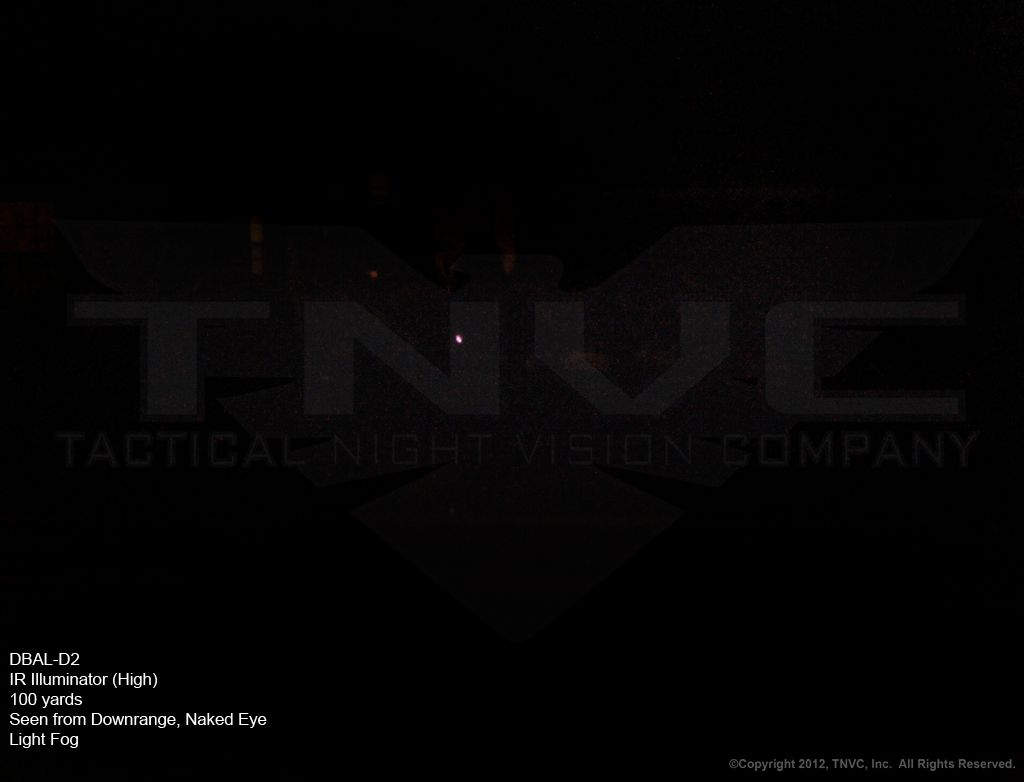
Now, let’s talk turkey: pricing. The DBAL-D2 is not an inexpensive unit. It is available in four configurations: Anodized Black or FDE housings and Red or Green visible lasers. The MAP price on the units with Red Visible Lasers is $1,485 while the ones with green lasers will go for $1,733. This is a pricing structure that is strictly enforced by the distributor. So, all of you want to know is it worth it? The short answer is yes. And here’s why: The versatility and capabilities of the DBAL-D2 far surpass any and all multi-function lasers on the civilian commercial market. It has all three capabilities of the military-issue AN/PEQ-15 in a package that can be bought by a civilian. Both integrated lasers are incredibly high quality and feature the same precision as their government counterparts. The windage and elevation adjustments are positive and robust. They are slaved together for ease of operation as a bonus. But, you’re not reading a review about the DBAL-D2 to find out about the lasers. You want to know about the illuminator. Well, if the images above don’t paint a good enough picture for you, then consider this: the DBAL-D2 puts all the features of a high-power illuminator and aiming laser combo into one unit. Is it possible to go out and purchase a regular DBAL-I2 and pair it with a secondary IR illuminator? Sure. But, now you have two devices that are hanging off your gun, taking up more real estate on the hand guards, and adding more weight. Think about it; if you are using a night vision scope or clip-on device, you will have to mount the laser on the side rail. With a separate laser and illuminator combo, you will have one unit at the 3 and the other at the 9 o’clock. With a bipod at the 6, where would you mount a white light? Yes, even hunters can benefit from weapon-mounted white lights. Or, let’s you’re using a head-mounted NVG and have separate units. Now, you have a laser at the 12, an illuminator at the 3, a white light at the 9, and a vertical grip at the 6. That is a lot of shit hanging off your gun (not to mention a ton of weight).
Also, let’s talk about the capabilities. The IR illuminator in the DBAL-D2 is one of (if not, the most) powerful units on the market. Like I said, at the TNVC we will give you a no-bullshit answer. So, I am comfortable saying that the DBAL-D2’s IR illuminator outperforms our own ELR-Torch by double. Look back at the photos. That’s 800 yards of IR illumination. And, it is a much more durable unit. Remember when I said you could beat someone to death with the DBAL-D2, put it on your gun, and it will still work? Well, try doing that with other illuminators (OK, don’t actually beat someone to death – that’s a felony. But, give other illuminators a good whack and see if they still work). The DBAL-D2 is built the same way as its Mil-Spec brethren. So, in the toughness category, it’s pretty much unrivaled.
Is it worth the price of admission? I would say yes. It outperforms rival units on every level. What’s more, it is made by Laser Devices, Inc.; a major U.S. Government contractor that supplies hundreds of thousands of lasers to the Department of Defense. And it is made right here in the United States.
Like I said, this initial review was done with a prototype unit that was provided to us by the program manager for professional feedback. It is very close to a production model, but there will be some small tweaks made, but nothing that will affect performance or output. I know there are a lot of rumors flying around about the DBAL-D2, so hopefully this review clears up some of them. We are very excited about this unit and I believe it will offer a whole other dimension to the civilian hunter and sportsman. Currently, there is not a drop-dead release date. The D2 is going into production. We have been told that if everything goes according to plan, we should start having production units ready to ship out to customers in late March/ early April.
Thanks for reading,
Chip Lasky
Director of Operations, TNVC, Inc.
 Win a FREE Membership!
Win a FREE Membership!